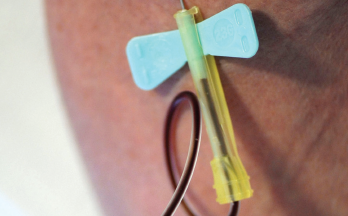
Jose Oto / Image Point France / offset
A recent study suggests costly antibody screening among patients with systemic lupus erythematosus could be reduced by limiting repeat screening of extractable nuclear antigens (ENAs). Researchers investigated how often results changed for anti-ENA and other commonly screened antibodies in repeat testing of patients with SLE. The findings were published in the Journal of Rheumatology.1
“We theorized, based on clinical experience, that seroconversion of anti-ENA would be uncommon and serial measurements would be unlikely to change from baseline testing; therefore, our intention was to study when to stop reordering tests that may lack future utility,” write the study authors.
Cost Factor
A majority of lupus patients test positive for anti-nuclear antibodies (ANA), which is part of an immunology screening panel typical for patients suspected of having the disease or other autoimmune disorders. If a patient suspected of having lupus has a positive ANA, doctors will typically follow up with additional testing for antigens that react with ANA, including anti-ENA, anti-double stranded DNA (anti-dsDNA) and complement components C3 and C4.

Dr. Pope
For patients with a positive ANA, it is important for prognosis to determine the values that are positive in the ENA series of SLE-associated antibodies, which include anti-Sm, anti-RNP, anti-Ro/SS-A and anti-La/SS-B, explains corresponding author Janet Pope, MD, a professor of medicine, Division of Rheumatology, Western University of Ontario, Schulich School of Medicine, London, Ontario, Canada. These serologic markers are associated with more SLE damage, increased renal risk, photosensitivity and other connective tissue disease features, says Dr. Pope.
Although annual serology testing for patients with SLE is common, the authors note the cost effectiveness of continued testing for anti-ENA has not been established. Knowing the values of autoantibodies in anti-ENA is important, but in general they do not change in the lifespan of the disease, thus repeat testing during routine follow-up “to look at the antibody profiles is futile and costly,” according to Dr. Pope.
“Lab testing accounts for a lot of money spent that could be directed into other areas of healthcare if the testing is unnecessary,” says Dr. Pope.
Exceptions
Exceptions that would merit repeat anti-ENA testing include for a patient with SLE who is pregnant or considering pregnancy, notes Dr. Pope. For example, anti-Ro and anti-La antibodies increase the chance a fetus will develop congenital heart block. Repeat testing may also be called for if the diagnosis is uncertain given that a small number of patients with SLE are ANA-negative yet Ro/SSa positive, according to the article.
Overall, there were no changes in anti-ENA screening for 89.4% of patients over the study period. … Rheumatologists could save money by not ordering repeat tests that, with some exceptions, don’t change over time, says Dr. Pope.
The Study
Researchers reviewed annual antibody and complement testing recorded in the charts of 130 lupus patients enrolled in the 1000 Canadian Faces of Lupus prospective registry. Specifically, they analyzed the annual seroconversion frequency for anti-ENA antibodies, anti-dsDNA and C3 and C4—from one test to the next and over the entire follow-up period, given one or multiple consistent results—and they calculated what it cost to detect the changes.
To be included in the study, subjects had to meet the ACR criteria for SLE and have a least one repeat test for all analyzed marker types at one year after the first test.
Overall, no changes in anti-ENA screening were reported for 89.4% of patients over the study period. Results for the remaining patients showed that 3.3% changed from negative to positive and 7.3% from positive to negative. Following a single anti-ENA screen, there was a 3.9% change from negative to positive tests and conversely a 4.2% change from positive to negative. After years of consecutive multiple consistent tests, the frequencies of changes progressively declined, according to the article.
In comparison, the other markers that were tested changed more frequently than anti-ENA. The rate of patients with no changes after the first test observed was 60.8% in anti-dsDNA, 83.3% in C3 and 75.4% in C4.
Cost for repeat testing of the anti-ENA screen was more than for the other biomarkers evaluated. Researchers estimated the Medicare cost at $621 to detect one anti-ENA change to positive one year after an initial negative screen and roughly $2,000 to $3,000 with each following year, according to the study article.
The Medicare cost to detect anti-dsDNA change to positive was estimated at roughly $238 after the first annual test and remained below $700 after four consistent years. The cost to detect low C3 and C4 was estimated just under $220 each, according to the article.
The authors note that repeat serologic monitoring of patients with SLE adds to healthcare costs. In particular, the research shows the costs to detect infrequent changes with anti-ENA testing were significant.
“Consistent with our clinical observations, we documented a low frequency of changes (<5% over the study) among anti-ENA autoantibodies in patients with SLE enrolled in a prospective cohort,” states the article. “These data suggest that it is not necessary to repeat anti-ENA testing during routine follow up, because the initial test result is unlikely to change.”
Actionable Data
Rheumatologists could save money by not ordering repeat tests that, with some exceptions, don’t change over time, says Dr. Pope. The cost to the patient runs about half the price of a follow-up visit, and the results provide minimal new information, she says.
“So it’s not worth it,” says Dr. Pope, noting that tests for anti-ENA should be ordered once in an SLE patient “unless a new disease has evolved, such as another connective tissue disease.”
“However, if a patient is contemplating pregnancy or is early in pregnancy and her previous status was Ro negative, then you may want to check to see if it became positive,” says Dr. Pope.
The study found anti-ENA results seldom change one year to the next especially after one or more test is negative. Anti-dsDNA and complements change more frequently after an abnormal result, but less after a normal value, the authors concluded.
“While we did not investigate the clinical implications of changes, published data show little predictive value of anti-ENA,” states the article. “Routine annual anti-ENA testing is likely not necessary in SLE-patients with consistent results, especially if they are negative.”
Study limitations noted by the authors include that data were collected from a single site and researchers did not assess whether changes in test results correlate with any clinical or treatment event. In addition, most tests were performed at one laboratory, which may limit applicability to patients whose tests are performed at multiple laboratories.
Catherine Kolonko is a medical writer based in Oregon.
Reference
- Raissi TC, Hewson C, Pope JE. Repeat testing of antibodies and complements in systemic lupus erythematosus: When is it enough? J Rheumatol. 2018 Jun;45(6):827–834.

